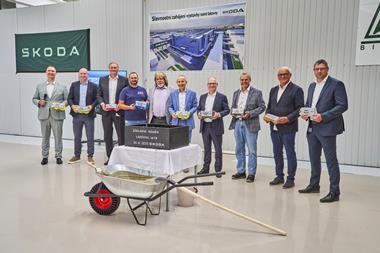The rise of ADAS will require a massive increase in the number of sensors and other electronic components that are built into vehicles. Henkel looks at the production challenges and solutions relating to this technology

Advanced Driver Assistance Systems, known as ADAS, are transforming the way vehicles are driven. They use dedicated data modules and sensors such as cameras, radar systems, ultrasonic sensors, and Light Detection and Ranging (LiDAR) systems that map out the vehicle’s topological environment to identify potential hazards. This makes driving more comfortable – but that is not the real purpose for ADAS, it is just a by-product. These innovative systems play a life-changing role in keeping drivers, passengers, and pedestrians safe.
It is estimated that somebody dies in a road traffic accident every 22 seconds and this needs to change. ADAS has the potential to make a significant contribution to increasing road safety and promoting progress toward the ultimate goal of eliminating traffic-related mortalities. So, ADAS does not only stand for comfort and convenience, ADAS means SAFETY. And that is why ADAS is such an exciting technology.
At Henkel, we offer a portfolio of high-impact solutions for ADAS that support our customers in their efforts to transform automotive electronic component designs and make the roads safer. The rise of ADAS will require a massive increase in the number of sensors and other electronic components that are built into vehicles. Cars that were produced in the year 2000 featured on a global average four driving sensors and this has risen to approximately 15 in 2020. By 2030, we expect this number to increase even further. This transformation is going to turn the ADAS dream into reality. And our innovative technologies are making it happen.
Taking autonomous driving to the next level
Autonomous driving features on so-called Level 2 and 3* are already often common parts of the modern driving experience. Many cars feature cruise control or sensors and cameras that support parking, while some models even offer self-parking mode. However, Level 4 and 5 autonomous driving will take this technology even further – with self-driving vehicles that allow the driver to take their hands off the wheel, their feet of the pedals and their eyes off the road.
This will enable drivers to work, read or relax while travelling. It represents driver comfort at its best – but again, this is not the true aim of ADAS. This technology is all about maximising safety and making sure vehicles arrive at their destination while keeping drivers, passengers as well as pedestrians safe.
Cars that were produced in the year 2000 featured on a global average four driving sensors and this has risen to approximately 15 in 2020. By 2030, we expect this number to increase even further
Henkel’s solutions for ADAS
As the market for Advanced Driver Assistance Systems gathers pace and value, it is essential for these systems to always offer reliable performance. This means the companies that manufacture the components and modules that ADAS relies on need solutions that ensure optimal performance from the moment the engine starts, even in hot or cold temperatures or harsh environmental conditions.
In addition, the massive increase in the number of sensors that are integrated into car designs also places new demands on manufacturing processes. Companies in this market require solutions that support high-throughput assembly, fast and easy handling and curing, or specialty solutions that eliminate fogging on optical camera lenses and LiDAR systems. And of course, they also need environmentally compatible solutions that maximise efficiency, minimise waste and support progress toward sustainability.
Henkel places a laser-sharp focus on empowering its customers in this market. We are extremely passionate about what ADAS can achieve and we offer a portfolio of solutions that address the full range of current and future challenges related to this technology. On top of this, our dedicated product development teams around the globe are constantly working on innovative new solutions – based on our deep understanding of the unique needs of companies in this market.
Henkel has a long tradition and well-established presence across the globe in all aspects of electronics assembly applications for the automotive market. We combine our focus on ADAS with our industry-leading portfolio of solutions – and this makes us the partner of choice for our customers as they seek to engage in strong collaboration and explore innovative solutions.
We strive to be much more than a materials supplier. We aim to be THE total solution provider for ADAS component assembly. And with our deep expertise and innovative portfolio, we make it happen.
*Levels of autonomous driving
L1: Drive assistance, L2: Partial automation, L3, Conditional automation, L4: High automation, L5: Full automation
The key technologies for enabling ADAS
Our experts work closely with companies across the automotive and electronics industries to develop a detailed understanding of the practical requirements of creating ADAS solutions. Based on this, we believe the following technologies will play a key role in enabling ADAS:
• High-reliability solders and underfills that guarantee long cycle life and zero failure.
• Non-conductive adhesives for cameras with high glass transition temperature, low thermal expansion and ultra-fast-curing to achieve fast, effective alignment and high throughput.
• Sustainable, non-CMR (Carcinogenic, Mutagenic and Reprotoxic chemicals), REACH-compliant materials that meet demand for safety and environmental compatibility.
• Flexible and self-regulating heating solutions for defogging and defrosting that are specifically adapted to meet the full range of electronics applications – including ADAS.
• Thermal Interface Materials that eliminate system failures caused by over-heating in data modules, cameras or LiDAR modules and eliminate fogging for optical systems.
• Fast, snap-cure solutions including die attach, conductive adhesives and gasketing solutions that support high throughput.
Find out more here







































